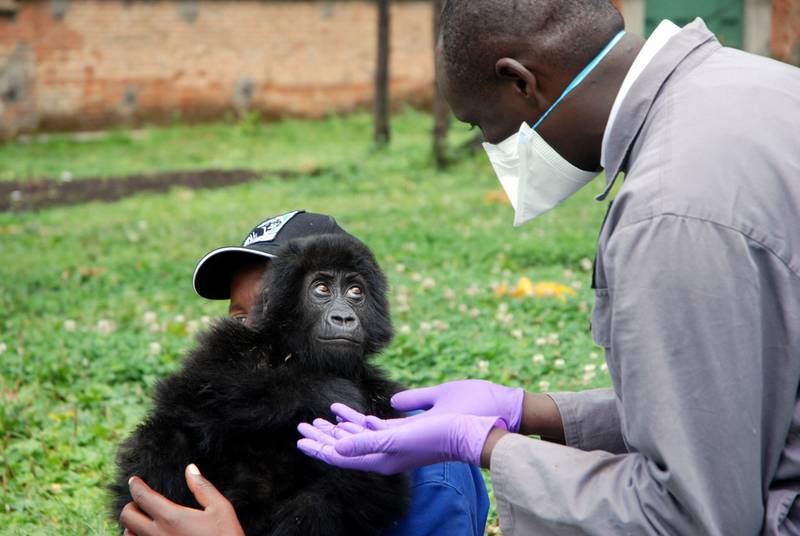New Gorilla Orphan Confiscated
Categories: Journal no. 43, Bushmeat, Threats, Democratic Republic of the Congo, Rwanda, Eastern gorillas, Mountain Gorilla, Gorilla Journal
A new orphan gorilla infant arrived in the night on Sunday, August 7th, 2011, at the care facility in Kinigi, Rwanda operated by the Dian Fossey Gorilla Fund International and the Mountain Gorilla Veterinary Project (MGVP). The newcomer is a female gorilla, confiscated from poachers by Rwandan police in the town of Gisenyi, at the border with the Democratic Republic of the Congo (DRC).
The little orphan, just barely over a year old was well enough, and, although she was not afraid of humans, she was very traumatized and underweight. She was captured on August 2nd at Bukima, on the Congolese side of the border in Virunga National Park, but arrived in Rwanda on August 3rd. Felix Ndagijimana, deputy director of the Karisoke Research Center, went to Gisenyi to meet with the principal organizations involved in the gorilla confiscation, including the MGVP, the Rwandan Development Board and the Congolese park authority (ICCN).
When the Congolese poachers, assisted by two Rwandan men, attempted to cross over the border to Rwanda, they were arrested and subsequently incarcerated in the Gisenyi jailhouse. They claimed that they did not capture the orphan themselves, but instead purchased her from an unnamed source for US$ 15,000.
A rescue team led by MGVP’s Regional Veterinary Manager Jan Ramer hurried to the jailhouse to rescue the little orphan late Sunday evening. Immediately, it was clear that she was suffering from some upper respiratory distress, likely a product of exposure to a human captor’s illness. However, with medical treatment and her nutritional and psychological needs met, she is now healthy and will soon be ready to travel to a new home.
The young gorilla is cared for in Kinigi while she waits out her one-month quarantine period. Ihirwe’s rehabilitation facility is located at the base of the Virunga Mountains. It is safely enclosed by a tall brick wall which encloses a large lawn, equipped with wooden climbing structures and a night house. Ihirwe is never alone and is accompanied by one of her three caregivers at all hours of the day and night. She spends sunny afternoons out in the grassy play area where she teeters around on two legs while raising her little arms up towards her human caregiver. The caregiver casually picks her up and swings her around for the hundredth time this afternoon.
Jean Bosco Noheli of MGVP visits Ihirwe periodically to assess her medical condition and monitor her development. She is growing stronger and more confident by the day. MGVP and the Fossey Fund are excited that they will soon be able to integrate her with other youngsters of her kind in a larger, more natural setting as soon as she is ready and her subspecies is determined.
Although Ihirwe’s one-month quarantine period is completed, the Dian Fossey Gorilla Fund and MGVP are waiting for one final piece of information before her big move. The results of her DNA analysis will determine whether she is indeed a mountain gorilla or a Grauer’s gorilla. This will determine her future residence. If a mountain gorilla, Ihirwe would join four other recent graduates from the Kinigi facility in the Senkwekwe center, in a more natural, rural setting in Rumangabo, DRC that ICCN developed for confiscated mountain gorillas. The other option would be the Gorilla Rehabilitation and Conservation Education (GRACE) center for Grauer’s gorillas, in the DRC.
Ihirwe’s samples were sent to the Max Planck Institute for Evolutionary Anthropology in Germany. Jan Ramer hopes that, given their extensive database of information, they may also be able to determine Ihirwe’s natal group, a fascinating possibility for the gorilla conservation community.
Jean De Dieu Ngilira, head caretaker at the Kinigi orphan facility, says that he is pleased with Ihirwe’s progress. She has a great appetite and enjoys eating lots of bananas, carrots and pineapple. They are also supplementing the infant’s food with milk and wild celery. It is important to the MGVP and the Fossey Fund that she be exposed to various food sources from her native habitat. Although Ihirwe has attempted to strip the celery stalks to access the nutritious inner core, she has not yet mastered the technique and still depends on her caregiver’s deft fingers.
It took several weeks for the orphan to gain enough confidence and comfort in her new surroundings to start playing. Even then, she would separate only a short distance from her caregivers before running back to the safety of their touch. In mid-September, she began to entertain herself, and started climbing the small trees in her enclosure and playing apart from her caregiver for extended periods of time. This excellent development suggests that she will soon be ready for her move to Senkwekwe or GRACE.
Jessica Burbridge

